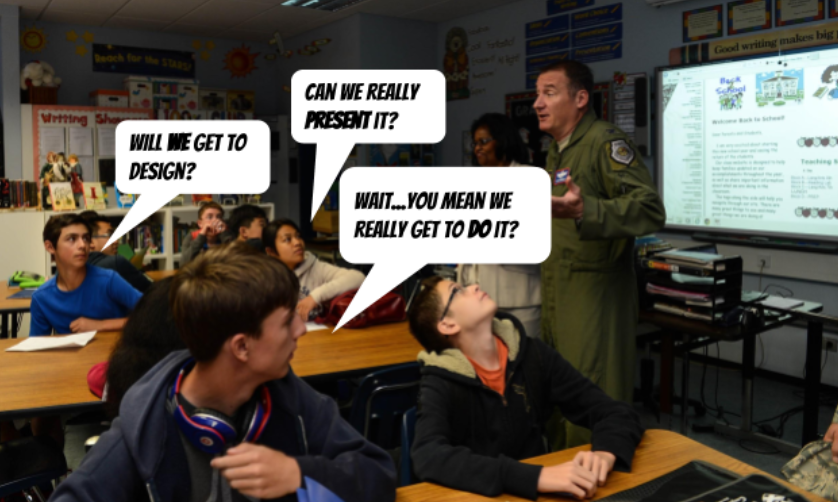Ask students a simple question, and they will never cease to amaze you.
Like this one: “If you were creating this class, what would you have students do?”

This is some of what we heard when we asked a group of 8th grade students to help us redesign the current 7th grade Career Exploration course at their school. These responses, above anything we heard from the educators, drove every development decision we made as we drafted a 10-week Career Exploration Program.
The students we were talking with attend a school in a Michigan community that appreciates for the need for all learners to explore the current and future job market. Recognizing the attention that career and college readiness is getting at the national level, school district leaders partnered with a few of our ALP colleagues to re-envision the current 7th grade course. The goal for this project was to design authentic learning experiences and integrate best practices that engage learners and elevate agency across a variety of content areas, while uncovering those interests and skills that may inform decisions about future careers and jobs; including high school course selection, CTE program enrollment, and transferable skill development.
Inspiration Through Ideation
While brainstorming how to make this happen, we decided to learn about the current experience from those who know it best — the teachers and learners. With the help of district leadership, we put together a two-day schedule that would allow us a number of different touch points. We met with a group of teachers to review their current course materials and discuss successes and challenges, and we collaborated with a steering committee of district/school leaders around desired outcomes. This provided a comprehensive overview of the adult’s perspective.
The powerful drivers for our work revealed themselves when we started asking learners questions.
- Which class, of all the classes you’ve ever had, has been your favorite? Why?
- What is the best lesson you’ve ever done in school?
- What did you like about the Career Exploration class you took last year?
- What would you change or do differently? Why?
Based on what we uncovered on the first day, we designed and modeled a lesson with current 7th grade learners that allowed us to gathered feedback on the learner experience. Then we met with three focus groups of 8th graders to hear from them about what they liked and disliked about the course they took the previous year. We asked them to dream about what they would change and how they would change it. They were able to describe in detail activities like poster sessions, wax museums and sciences labs that they still remember as being powerful and fun learning. They were also able to name opportunities they wish they had more often, like collaborating with classmates, deeper focused research, authentic simulations and (of course) field trips.
Armed with the learner perspective, we engaged in a development and design period that resulted in a Career Exploration Program that took the composite learner dream to the next level. As requested, we worked in collaboration opportunities, technology simulations, authentic challenges, connections to real people, and self-exploration experiences. We were deliberate about building skills across the areas of research, information fluency, communication, collaboration, and critical and creative thinking. And we embedded as many authentic learning experiences as we could into the 10 week course.
Empowered to Take Action
At the end of our development period we returned to the district to deliver the content. The teachers were excited to pilot, the steering committee was excited to see it at scale, and the learners reacted in a way we never imagined.
We walked them through an overview of the course and provided a few examples of the types of experiences we designed, emphasizing how their feedback had influenced some of our decisions. They were genuinely interested in the types of activities learners would get to do and asked questions about elements that were important to be sure we were able to find places to work those in. The longer we talked, the more excited they got about interviewing park rangers, designing business logos, hosting job fairs, engaging in CSI-type simulations, writing code, and creating a solution for the backpack challenge. The energy in the room was high and students were leaning forward on the front of their seats popcorning out questions as quick as we could answer them. These 8th graders, who wouldn’t take the 7th grade class again, started using possessive phrases around the project.
They were really starting to own it when one brave young lady took pause and asked, “Is there going to be a class like this in High School?” Our best response was to make sure they accepted the challenge to ensure it happened.
We thanked the learners for their contributions to the program development and did our best to describe how they could feel proud of the program they helped design. We told them that they were moving on to high school next year, but they had an impact on learning that will last long after they are gone. Their body language, facial expressions, and comments to each other revealed that they felt empowered.
One young man raised his hand and asked, “So, what you’re saying is, next year when someone talks about the backpack challenge, I can say, ‘I made that!’”
Yes, my friend. That is your legacy impact.

